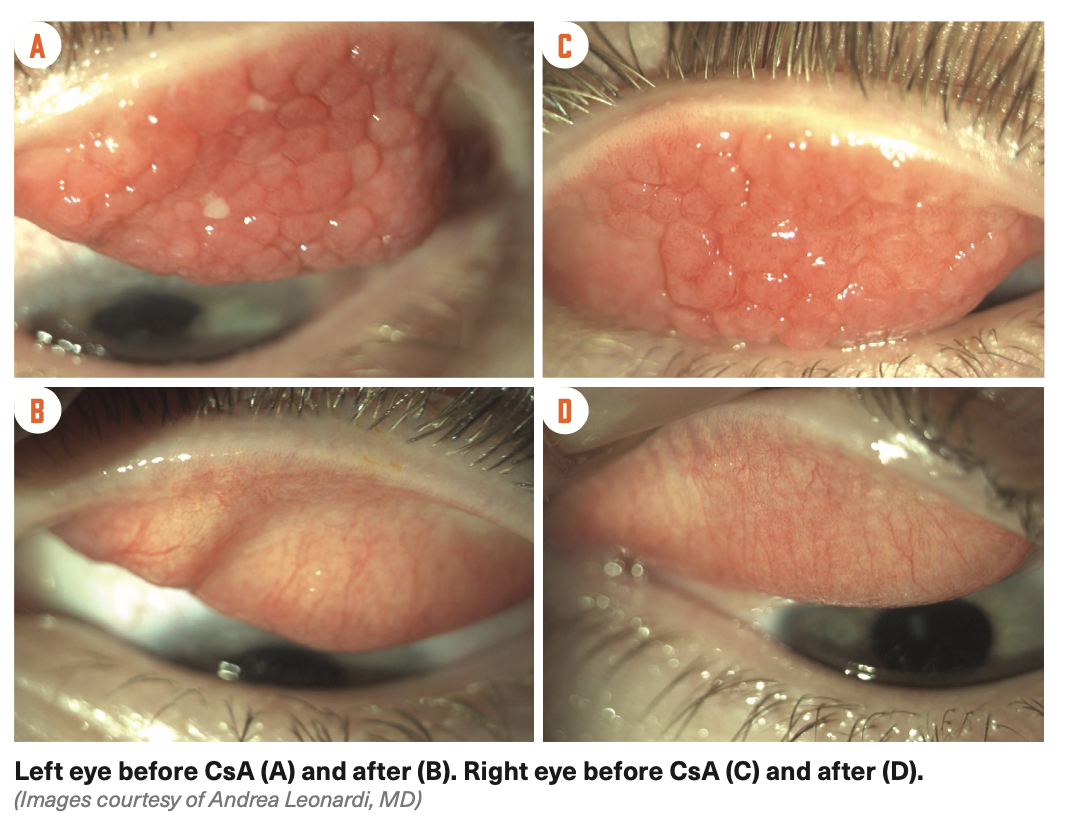Publication
Article
Digital Edition
FDA approves cyclosporine A eye drop for vernal keratoconjunctivitis
Author(s):
Most patients with allergic disorder are children, adolescents, or young adults.

Reviewed by Andrea Leonardi, MD, PhD
The FDA recently approved cyclosporine ophthalmic emulsion 0.1% (Verkazia; Santen Pharmaceutical Co, Ltd) for the treatment of vernal keratoconjunctivitis (VKC), a rare, recurrent allergic disorder.
Results of a 4-month efficacy study1 and an 8-month safety follow-up period2 showed that the signs and symptoms were quickly and significantly reduced by cyclosporine A cationic emulsion (CsA CE), and the extended therapy with CsA CE stabilized patients and did so while maintaining a good safety profile, according to Andrea Leonardi, MD, PhD, of the Department of Neuroscience, Ophthalmology Unit, University of Padua, Italy, and the senior author of both studies.
Most of the individuals affected are children, adolescents, and young adults who develop severe inflammation of the ocular surface.
Related: Scattered routines have ocular surface consequences
When the disease is severe, VKC negatively affects the patients’ quality of life, with symptoms including intense itching, ocular pain, and light sensitivity that can prevent those affected from participating in everyday activities.
The availability of this drug is important because without treatment, patients can progress to development of corneal ulcers and visual loss.
Another plus associated with cyclosporine ophthalmic emulsion 0.1% is that it addresses the underlying pathology of VKC without the risk of long-term adverse ocular effects.
Cyclosporine ophthalmic emulsion 0.1% works by inhibiting T-cell activation and reduces the level of immune cells and mediators that cause the chronic, severe, potentially debilitating allergic inflammation of the ocular surface in VKC.
Related: Novel vehicle contributes to cyclosporine efficacy
VEKTIS study
The VEKTIS study (NCT01751126), a multicenter, double-masked, randomized controlled trial, assessed the safety and efficacy of cyclosporine A cationic emulsion 0.1% eye drops over a 12-month period in pediatric patients with severe active VKC.
Initially, 169 patients aged 4 to 17 years were randomized to the 4-month VEKTIS trial, and of those, 142 entered the 8-month follow-up period during which the patients randomly assigned to the cyclosporin A cationic emulsion stayed on their original treatment regimen, ie, drop instillation 4 times daily (high dose) or twice daily (low-dose plus the vehicle twice daily).
Those receiving the vehicle were later allocated to 1 of the 2 active regimens. The main outcome measures of the study were safety and efficacy. The investigators recorded adverse events (AEs) associated with treatment and corneal fluorescein staining score.
Related: As cyclosporine options grow, focus remains on the vehicle
Compared with the patients assigned to vehicle, the patients on active treatment had improvements in staining scores, rescue medication use, and photophobia, tearing, itching, and mucous discharge.
The quality of life also improved, as assessed by questionnaire responses during the 4-month evaluation period.
The patients remained stable during the 8-month follow-up period, according to the investigators, with the high-dose regimen continuing to provide greater benefits in most efficacy measures.
The drug was well tolerated; AEs related to treatment were found in 15 patients who received high-dose treatment and 11 who received low-dose treatment, and the AEs were related mostly to the instillation side.
Related: The eyes offer conjunctival clue to COVID-19
Drug benefits
“Results from the VEKTIS trial showed that the significant improvements in VKC symptoms and signs and the quality of life with topical CsA were maintained over 12 months, with a significant reduction in the use of topical corticosteroids,” Leonardi commented.
In addition, CsA CE provided a rapid onset of action in patients with severe VKC, ie, within the first month of treatment, and because it is corticosteroid sparing, the potential corticosteroids-associated AEs are avoided.
Patients reported a significant improvement of quality of life regarding their ability to participate in daily activities, subjective emotional well-being, and symptoms.
Related: Researchers eye cure, diagnostics for adenoviral conjunctivitis
“CsA is a better drug for managing affected children, and parents express better ‘satisfaction’ with the drug considering that schooling, vacationing, and normal daily activities are compromised in affected children, which ultimately affects the entire family. In addition, clinicians can better control the disease in the short and long term, prevent recurrences of the disease during the worst season, and can use [fewer] corticosteroids, which contributes to a safe profile of CsA,” Leonardi concluded.
--
Andrea Leonardi, MD, PhD
E: andrea.leonardi@unipd.it
Leonardi is a consultant to Santen Pharmaceutical Co, Ltd, and the principal investigator of the VEKTIS study.
---
References
1. Leonardi A, Doan S, Amrane M, et al; VEKTIS Study Group. A randomized, controlled trial of cyclosporine A cationic emulsion in pediatric vernal keratoconjunctivitis: the VEKTIS Study. Ophthalmology 2019;126(5):671-681. doi:10.1016/j.ophtha.2018.12.027
2. Bremond-Gignac D, Doan S, Amrane M, et al; VEKTIS Study Group. Twelve-month results of cyclosporine A cationic emulsion in a randomized study in patients with pediatric vernal keratoconjunctivitis. Am J Ophthalmol. 2020;212:116-126. doi:10.1016/j.ajo.2019.11.020

Newsletter
Don’t miss out—get Ophthalmology Times updates on the latest clinical advancements and expert interviews, straight to your inbox.




